Travel
- Introduction (this post)
- Kaohsiung and Tainan, featuring Fo Guang Shan
- Spirited away to Jiufen, featuring tea houses, graves, and (lots of) rain
- Taipei, the famous jade pork, and the hotel emergency escape slide
- Conclusions (where I may put my foot in my mouth, we shall see)
- an Elixir programmer considering a side gig as a an artisinal cheesemaker
- a death metal singer that flew from the US to make connections and try to get a job
- a data analyst who made a “moneyball” database for Columbia Records for discovering hidden talent (I was finally able to learn from him exactly what an “A&R” is!)
- 🇹🇷 Istanbul (All Photos) 138 photos, 24 videos
- 🏛️ 1453 Museum and City Walls 7 photos, 7 videos
- 🏰 Topkapi Palace 25 photos, 4 videos
- 🕌 Hagia Sophia and surroundings 22 photos, 4 videos Also read my post on the Hagia Sophia here →
Had a nice time walking around Mannheim taking selfies in front of old/impressive things
Taiwan Trip Report pt 3: Taipei

This post is part of a series. See the introduction here →
Despite being the beginning of May Taipei was very warm. The sun was out as we walked the wide sidewalks around Taipei Station downtown, cars and scooters zooming by. Even when it was cloudy, crossing the Keelung River through the tech area of town (I spotted the Foxconn tower), the lush green mountains of the north were a tropical reminder. When we took the sky train to the eastern part of the city at Nangang, zooming along the edge of the pretty lake at Dahu Park, I was thankful I brought my sandals.
Half our time in Taiwan was spent in Taipei, a city that houses nearly 40% of the country’s population. It was nice to see some other cities and towns (as with most countries the capital city/economic center is not representative) but Taipei is a very enjoyable place. We travelled on trains and buses quite a bit and walked a few of the neighbourhoods. Taipei is a bustling city with way better international food than Japan (outside of Tokyo I suppose). Between trips to nightmarkets like at Raohe Street where we saw some great “bird fortune-telling”, we had tacos and steak and tacos again! The second floor of Taipei Station has all sorts of Thai and Korean and Japanese food. One late night when I was on my own, I finally partook in a Taiwanese Mos Burger, which actually was different than in Japan.
Highlights of Taipei
On the first hot day we took breakfast at a Soy Milk shop, a cramped little restaurant with a giant line of hungry tourists and locals out the front. We over-ordered many different breakfast delicacies and sampled all the little spicy and sweet sauces, crowded around a wooden table, our heads nearly touching. At the table in the corner I watched and old man rolling the dough for bao. He was in his own world, completely unbothered by the crowd, and quickly producing units of the perfect thickness with his practiced hands.
Hot stepping through the morning shadows to avoid the sun we made it to the Chiang Kai Shek Memorial, a massive white building at the end of a long strip of lawn that we avoided due to fear of being cooked. The grounds are bordered with a covered walk, so we took the coward’s way and I had to satisfy myself with some photos of the building from its corner. Inside was shaded but still sweltering. Up the long stairs is an open-faced alcove. The ceiling is decorated by an intricate pattern around the sun emblem found on the Taiwanese flag. Seated at the back of the hall is a giant statue of Chiang Kai Shek, the man who brought the Republic of China to the island of Taiwan after his defeat in the Chinese Civil War against Mao’s Communist forces. A few industrial fans moved the hot air around the room, but I couldn’t let myself feel sorry for myself. At least I was not in full dress uniform like the military guard! We timed our arrival perfectly to get a good view of the changing of the guard, an elaborate and excruciatingly slow and exacting performance. I almost fell over with heat stroke just holding my camera to capture it all! After 15 minutes of slow motion goose-stepping, then rifle spinning, then standing perfectly still (for the next hour I suppose) the process was over, we took some quick selfies and then retreated inside the air-conditioned building below.
The Chiang Kai Shek Memorial Building houses all sorts of displays and shops, but the main two areas really sum up Taiwan’s split personality with regards to its modern founding. When you walk into the main museum hall you turn left into a wing that lionizes Chiang Kai Shek, the military dictator of the country for 25 years, with displays of his letters, cars, and slippers. If you turn into the rightward wing of the museum you walk through a maze of photos and videos featuring the journalists and political prisoners that Chiang Kai Shek’s regime imprisoned.
CKS is certainly a complex person, and the pastiche I have just painted is particularly simplistic. But standing at the entrance, looking left and right, I was struck by how Taiwan is still dealing with its history. (Something I also felt at the National History Museum in Tainan)
(see the whole album in full screen on Flickr here)
Dragons
Later in the trip I had the opportunity to walk these streets at night. This area of the city has wide boulevards lined with many official buildings, all terminating at a giant roundabout where you get a great view of the President’s offices. I wasn’t able to get a good photo of it since I was rudely interrupted by a scooter accident that happened right in front of me. It happened like right in front of the National Taiwan University Hospital and a block from the Taipei City Police Department so the authorities were on the scene in a flash. Everyone seemed okay thankfully, but no cool night photos for Chad.
Luckily, I was able to go to Lungshan temple in the evening. Once again I was alone, so I could take my time photographing the elaborate rooves adorned with dragons. After feeling some cool spray from the purple-lit waterfall at the entrance, I crossed into the busy temple, where many people were throwing Moon Blocks over and over again. Waling the circuit of the temple complex, I peeked into each cubby trying to identify gods and goddesses. The place was overflowing with energy. I even picked up an omamori protective charm as a souvenir.
A lack of cabbage
Tucked into the lush hills on the north side of the city is the National Museum. As mentioned above, Chiang Kai Shek escaped the mainland during the Chinese Civil War. When he did he brought many treasures from China. 18 years later China went through the Cultural Revolution when the Red Guards destroyed much of China’s cultural artifacts. So many treasures lost! As a result, the national Museum in Beijing is pretty skint. But the National Museum in Taipei! Wondrous! There are so many pieces that you could return many times over to properly enjoy them. The tiny cabbage carved from jade is the most famous. Unfortunately it was not being displayed while we were there. I did get some good closeups of the jade meat though.
One highlight was seeing artifacts carved with kanji (Chinese Characters) dating back to the 13th-11th Century BCE! My kids said if they ever got access to a time machine they would go back and destroy these so they would not have to study kanji at Japanese school anymore.
There are amazing treasures here. One of my favourites is an ivory balls carved from an elephant’s tusk. The ball is carved with another ball inside, which moves! And inside that ball is another ball! The ball took over a hundred years, was started by the grandfather and finished by the grandson. Can you guess how many balls-inside-balls there are? (Hint, a lot more than Inception). Check the gallery below to see photos and the answer.
(see the whole album in full screen on Flickr here)
Actual Animals and Secret Slides
In Kaohsiung we saw a Grand Hotel but in Taipei we got to see the Grand Hotel. About twice the size of the one in the south, this hotel has hosted many famous dignitaries from around the world. Intricately designed there are many many details. The lobby alone features 144 pillars, 71 lanterns, and 220,000 dragons! We took a tour which included the secret slide installed to evacuate VIPs in case of emergency!
At the back of the hotel is the Centennial Dragon, which was a gift from Japan to the Taipei Jinja, the Japanese Shinto shrine that used to be on this spot. The story of the statue includes how it survived a plane crash. They know it is “obviously” a Japanese dragon because it only has 3 claws, which is how they did it back in the Tang dynasty. Since then Chinese dragons have evolved to 5 claws, but since Japan never changes…
(see the whole album in full screen on Flickr here)
For our final day we visited the Taipei Zoo, originally constructed about a hundred years ago by the Japanese (who really love their zoos!) We were able to get up close to many animals! The first section is Formosa animals: tiny deer, goat-like things, boars, the leopard cat, and then a huge sun bear. The zoo was too large for the half-day we had dedicated to it though, so we missed a bunch and went straight to the bird area which had the most amazing Nicobar pigeons.
(see the whole album in full screen on Flickr here)
At the end of the day the family took a gondola to the top of the mountain behind the zoo to get some nice night views of the city. Meanwhile I went back into the city on my own to meet with a local Microblogger at a lovely vegetarian restaurant. We had an amazing conversation, and made a great connection. I love meeting random internet people!
Next post I will try to consolidate some thoughts and impressions about Taiwan.
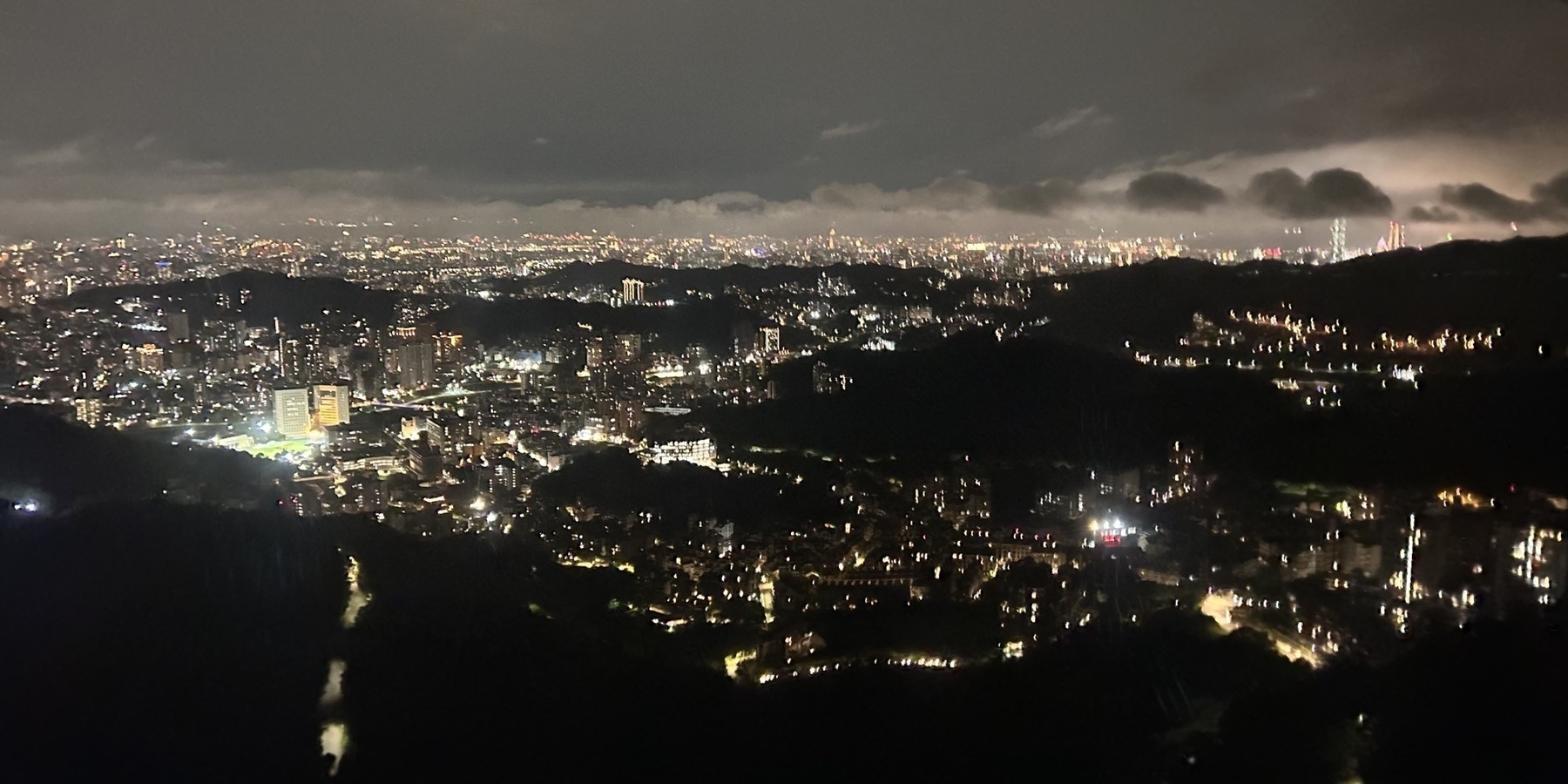
Jiufen
This post is part of a series. See the introduction here →
 (see the whole album in full screen on Flickr here)
(see the whole album in full screen on Flickr here)
The gold rush at the turn of the 1900s caused a boom in the small mountain town of Jiufen, with its sweeping views of the sea towards both the northwest and northeast. The narrow road switches back upon itself numerous times as you climb up the rugged mountainside. Across the valley, deep in the forest (with no visible road to get there) is a monastery poking through the trees. Once you make it to the town the road narrows even more, hairpinning around houses almost stacked upon one another. Take care to drive slow as knots of tourists suddenly run across the road to take photos of the rolling green valley below, or spill out of souvenir shops and the covered “Old Street” full of shops selling everything from ocarina to stinky tofu.
Our driver took us to the top of the mountain, the far side of the town where we had a view of the valley below. Down the hill we saw the telltale shapes of the family grave sites, which sorta look like the ones you see in Okinawa (cultural connections!). In fact, when you look on a map, you realize that half the town is graves!
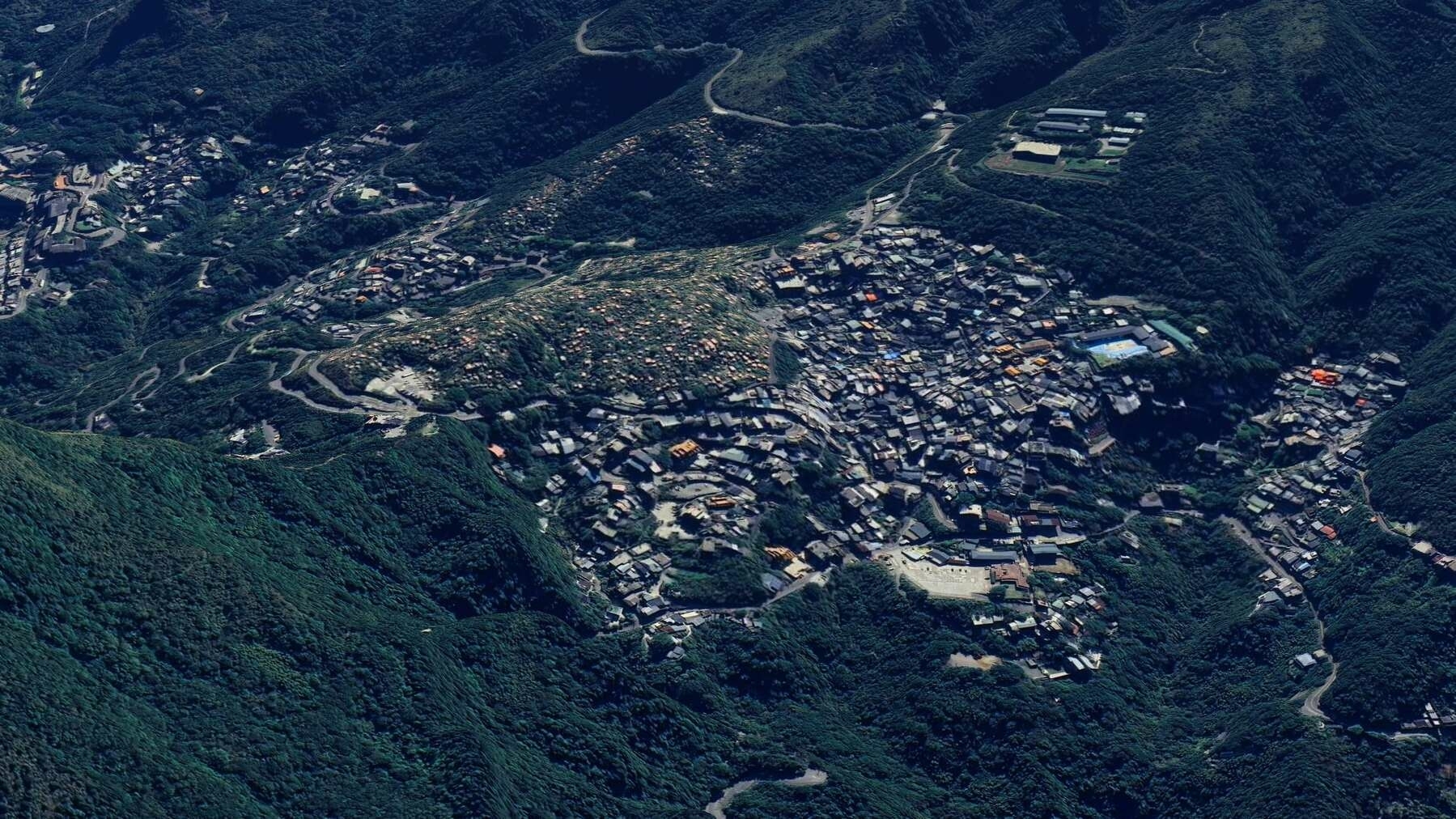
It was raining when we arrived. In fact, it rained almost the whole time we were in Jiufen. Our driver could not navigate through the narrow streets and called our B&B owner who retrieved us on a scooter. We followed him on foot wheeling our luggage down the steep road lined with graves.
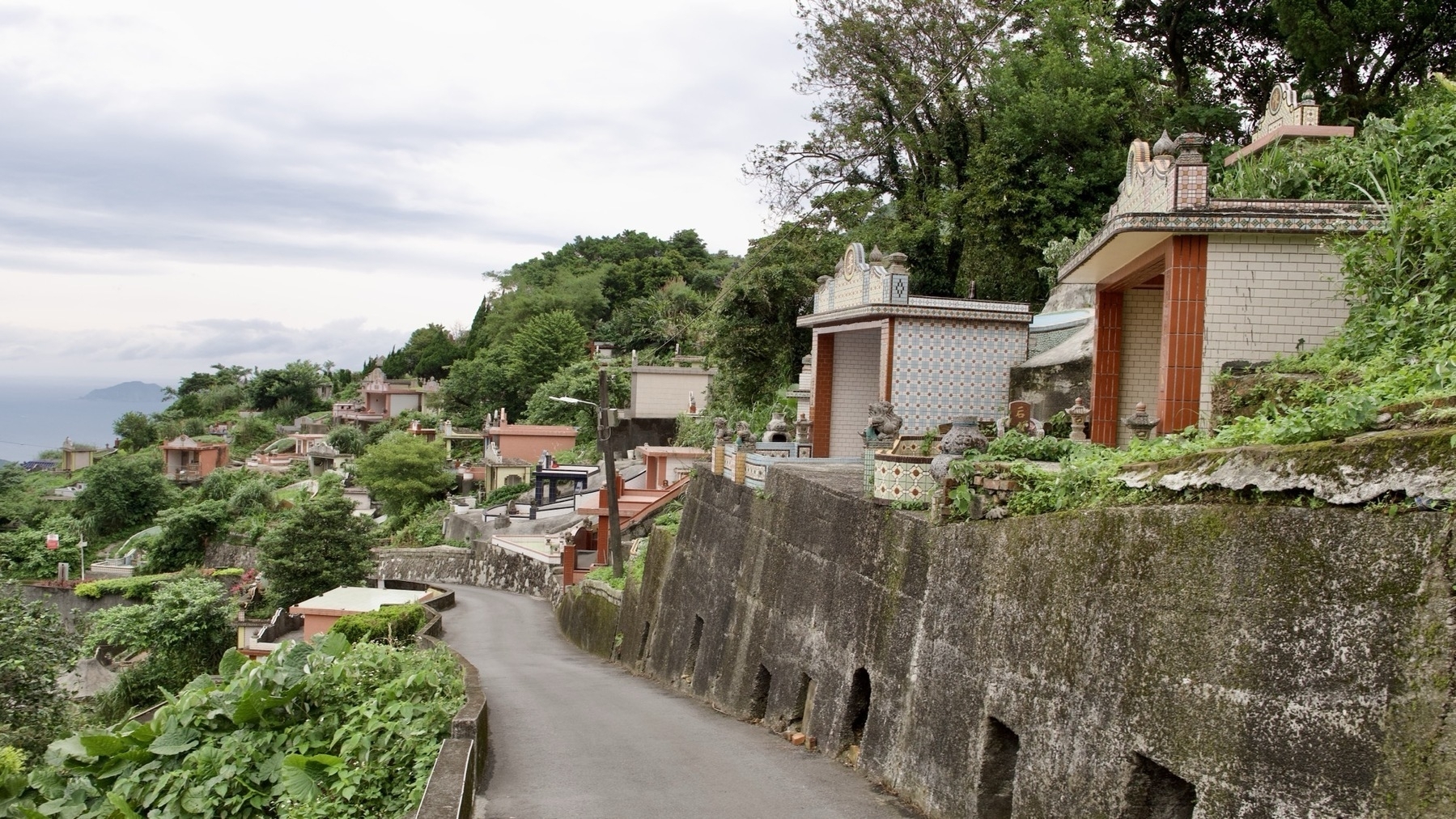
A few switchbacks later we made it to the B&B and dropped our luggage. “How do we get to Old Street?” He just pointed “That way!” and we were off, picking our way between houses, down random-seeming stairways, passing stray cats. There were no people, but these were no roads. We were silent as ghosts, scared to wake anyone. As long as we were heading down we knew it was the right way. Soon we came upon a narrow stairwell between two buildings leading down to a river of tourists flowing left and right in the covered shopping street.
Jiufen Old Street greeted us with the loud sounds and colours and smells of a crowded shopping area. Following the flow we branched off, stopping in a restaurant eddy where I had my first Vegetarian Red Vinasse Taiwanese Meatball. Continuing on were shoe stores and tea shops and every kind of knick-knack you can imagine, all hauled up to the top of this mountain to be sold to visitors who hauled themselves up here to buy.
But why? One reason, at least for the Japanese, is the A-Mei Teahouse, a distinctive building that has been said to be one of the inspirations for the bathhouse in Spirited Away (though Miyazaki denies this, and there are a number of onsen in Japan itself which claim this title). The souvenir shops cashed in with all sorts of Totoro and Ponyo and other Ghibli goods. The guy in the ocarina shop playing Joe Hisaishi tunes was actually pretty talented!
We took photos in front of the A-Mei Teahouse, and with a statue commemorating the gold miners in front of the building, but we took refuge in another teahouse further down the street, one with a fantastic view of the valley. This was my first Chinese tea experience. Not quite the same as cha-no-yū, but still with a recognizable level of ritual. The gentle spa music lent to the relaxing atmosphere as we drank cup after tiny cup of the smooth tea, watching the wind blow clouds up and over the mountain ridge above us. I recalled one of the one-stroke calligraphy pieces by Master Hsing Yun, the founder of Fo Guang Shan: Your mind a mountain, letting the clouds pass by.
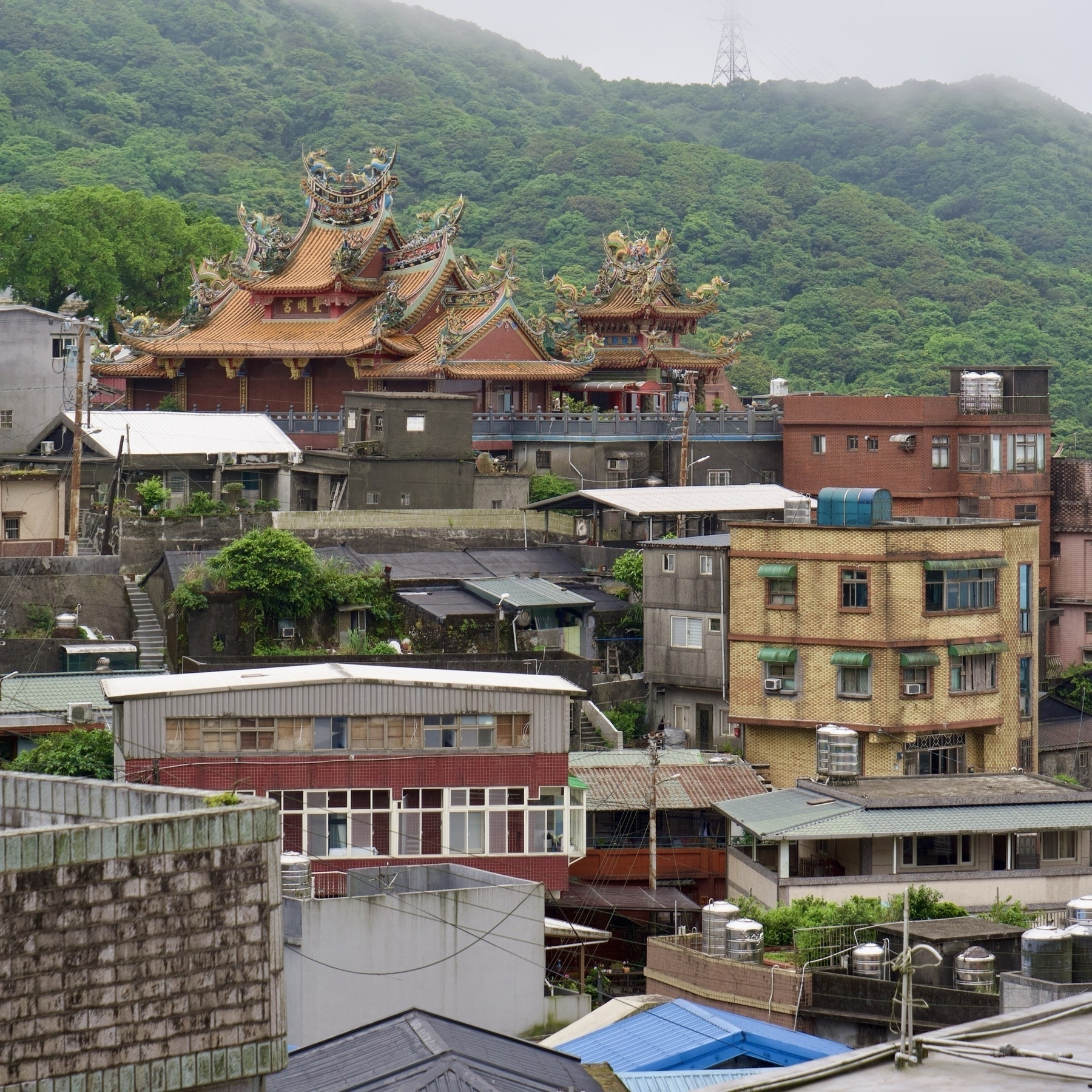
It started to rain again so we huffed up, up, up! Stairwell after stairwell we got progressively more soaked as we poorly navigated the maze back to our lodgings. Once back it was straight into a hot shower to ward off any sickness. Later, my wife and I walked back down and had a browse, picking up some dinner to eat back in the room. After dark we climbed up yet more narrow stairs to the roof of our B&B to take in some night views.
Waking early the next morning it was back down to Old Street before breakfast. The whole scene was very different: shutters closed, the street empty of tourists. Where yesterday there were throngs of people, now vans and trucks drove with their headlights on and barely enough clearance on either side. The narrow one-way street meant we had the pleasure of experiencing Jiufen’s daily morning traffic jam: each vehicle forced to park for long minutes as the vehicle in front finished its job of loading garbage or dirty hotel sheets, or dropping off a batch of tofu ready to be steeped in the stinky broth for the day’s sales. It was kinda like the feeling when you leave your hotel in the morning and the cleaning staff is getting to work, the mystery of the night before gone.
We stopped in the Family Mart for a little coffee and morning snack. At the back of the convenience store was a seating area with large windows, overhanging the cliff. Probably the best view from a convenience store I have ever seen. After breakfast we hiked back up to the top of the mountain and took in some more views. As I was photographing the valley we could hear the distant sound of drums, the popping of firecrackers, and see the occasional firework launched high into the air below us. May 1st.
Before noon we caught a taxi for the 45 minute drive back to modern Taipei, which is where we will pick up the story next time! 🚕
Kaohsiung and Tainan, featuring Fo Guang Shan
This post is part of a series. See the introduction here →
(see the whole album in full screen on Flickr here)
Kaohsiung is a port city in southern Taiwan, developed by the Japanese as an important industrial hub. We hired a tour guide who carted us around to different locations including the port area, the old British consulate, the art walk, and to one of the most intensely nerdy coffee shops I have ever seen (run by what I am pretty sure are devotees of the Falun Gong new religious movement , check out the art to see what I mean).
Driving the streets of a non-capital city gives you another perspective into the lives of regular folk. I like just cruising and taking it in: a crowded row of store signs in bright Chinese characters pass by; students leaving university crossing the street as scooters wend past our vehicle to crowd the crosswalk; commuters in various Japanese and European cars; trucks hauling goods; glimpses down side streets as people take out their laundry or play basketball at the courts. Snapshots of lives. After the expertly brewed coffee came a sumptuous condensed-milk infused shaved ice topped with mangos and strawberries to cool off and consider all that was seen.
Fo Guang Shan
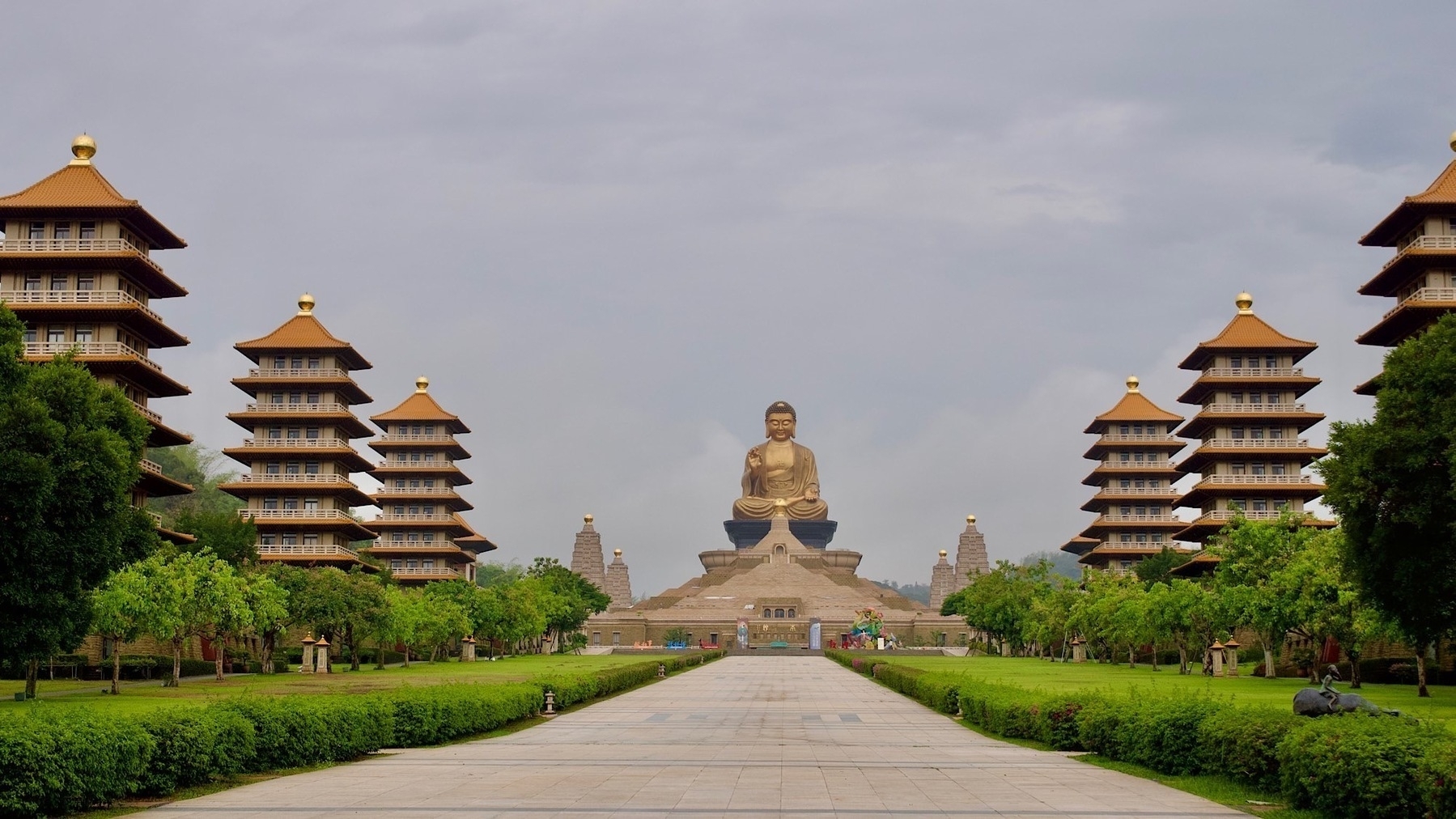
One highlight was visiting Fo Guang Shan (album) one of the four major temples of Taiwan, and home to a Buddha Tooth Relic, of which there remain only three in the world. This temple complex, built in the 1990s, is absolutely massive. Once you pass through the main entrance building which features an information center, a couple of restaurants, a bunch of souvenir stores, and a Starbucks, you are on a wide path lined by eight pagodas that leads to a main hall. Behind that hall is another building with a giant Buddha statue, overlooking the entire complex.
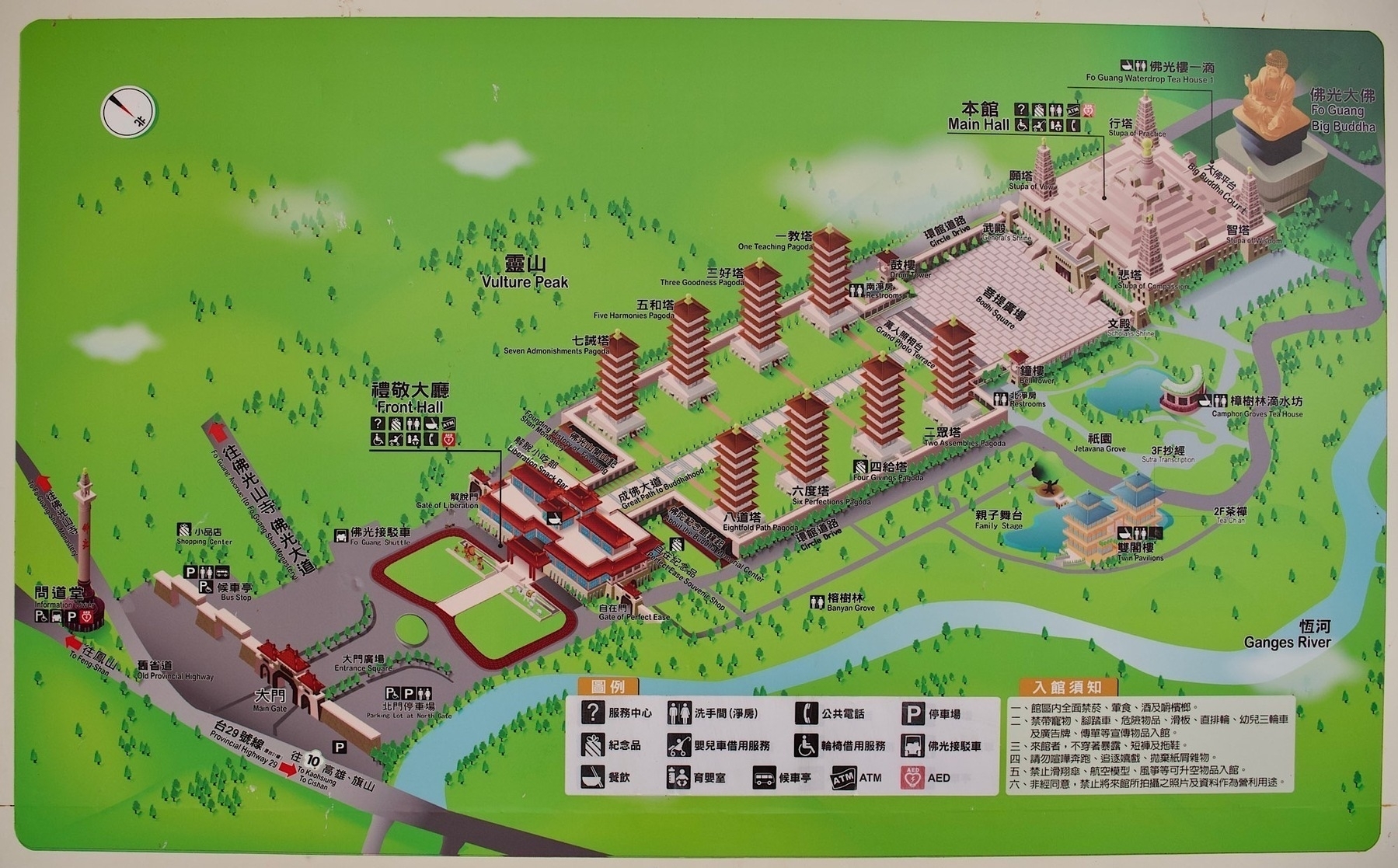
Each pagoda in itself is a museum of sorts. We went into just two: an information center with the history of the temple and teachings on the Noble Eightfold Path. The other pagoda we visited featured the One Stroke Calligraphy of Venerable Master Hsing Yun, the founder of Fo Guang Shan, who took up calligraphy after losing his sight — thereby restricting him to using just one stroke since he could not see where the characters were on the page.
We did not have time to peek into all of the pagodas, and since it was raining we followed the covered path that runs on the outer edges of the main route. Here we brushed our fingers along the dark stone walls, engraved with the names of every single person that donated money to the construction of this holy complex (photo). (We spotted a number of Japanese and English names too!)
Unfortunately photos were restricted in the main building. In the lobby I was able to take a shot of a carving of the 500 Arhats sculpted from roots of a 1000 year old camphor tree. Beyond that were a number of sub-shrines in this building. We navigated through groups of pilgrims and into the main temple dedicated to Guanyin (Kannon in Japanese). This was a very modern facility, circular with glass walls emblazoned with important religious figures, backlit by neon lights. The main altar featured a statue of 1000-hand Guanyin and some animatronics, and a line of small plastic bottles with red caps. At the direction of a helpful attendant, we paid our respects to Guanyin, and he filled one of the little bottles full of holy water from a dispenser in the altar. Later that night I poured some of the holy water over my head in the shower, and I think it worked! I never got sick the whole time in Taiwan, and I famously get sick on the fourth or fifth day whenever I travel abroad. We kept a few bottles to take home and put on our home altar as offerings to our ancestors.
Anyways, behind the circular shrine is a very square shrine with a heavy-looking gold statue of the Shakyamuni Buddha gifted from Thailand. This was another opulent room, which can be a little disorienting if you are used to understated Japanese temples. Next was the main show: the tooth relic. This large shrine room has a very high ceiling with wood panels carved in the images of famous Buddhist temples from around the world. I recognized Bodh Gaya right away. At the front of the room is a large Buddha, lying on one side, carved from white jade from Myanmar. Above is a little nook with the reliquary which contains the tooth. At the prompting of a nun, we each took a little battery powered candle and reverently walked up to the altar, placing it there as an offering. I just sat and stared for a while enjoying the ambiance until a large tour group came in — which is always my cue to leave.
The final area of the complex to see was the giant Buddha statue. We took a bunch of photos here, and circumambulated the Four Noble Truths Stupas on the four corners of the Main Hall, each shaped like the Mahabodhi Temple in Bodh Gaya. Symbolism is everywhere at Fo Guang Shan.
After this we took a very lovely vegetarian meal and browsed the shops. In all we spent just a few hours at Fo Guang Shan, but you could very well spend a couple of days here.
A few more spots around the south
Back from Fo Guang Shan we stayed at the Kaohsiung Grand Hotel (album), a much smaller (and ahem… cheaper) version of the Grand Hotel in Taipei.

Here we relaxed in the pool, I caught up on some writing, and we watched some local television. A Fo Guang Shan channel had a bunch of religious information. An “ethnic” channel featured indigenous programming in languages that sounded very different from the Mandarin and Hokkien we heard on the streets.
For our last day in the south we drove up to Tainan, about 45 minutes north with our guide where visited the large and newly made National Museum of Taiwan History. We spent as long as we possibly could until the kids were tired out learning about the full history of Taiwan from prehistoric times, the settlement of mainland Han Chinese, indigenous communities, repelling the Dutch, the Japanese era, the postwar economic miracle, and a bit about the issues facing Taiwanese today and in the near future. I took many notes, but to be honest the facility raised a lot more questions.
After the museum we rounded off our stay in the south by visiting the old Dutch fort (Chikhan Tower) and doing some shopping at the narrow Shennong Street before catching the High Speed Rail north to Taipei. Being the evening train on a holiday weekend, it was packed, so we had to stand for the one and half hour journey.
Next time, northern Taiwan! 🚅
Taiwan trip report - Introduction

Taiwan has been on the bucketlist for a while. In the year 2000 I was an exchange student in Kyoto learning Taiwanese from a fellow exchange student who was so excited for elections that he flew back to Taiwan to vote. That was only the second presidential election since the military dictatorship (which ruled from 1949) had transitioned to democratic elections in the nineties. In 2000 things were very exciting since it was the first time an opposition party won the presidency.
My wife too had a Taiwan connection in 2000. She was friends with a different exchange student, a Korean Buddhist nun, who went on to live and study in Taiwan for many years. That was when I first learned how much of a Buddhist religious center Taiwan is, hosting monastics and scholars from all over the world. Taiwan’s religiosity also contributes to its high percentage of vegetarians, which is second only to India.
In the intervening years I have had many friends travel and live in Taiwan. When I said I was finally going, everyone was excited and encouraging: “You are going to love it!” And you know what? I did love it. And I would love to go back someday. Mostly because so many of my questions about the place were not answered… but more on that later.
I am no expert on Taiwan. Our trip was only 8 days and we mostly engaged in sight-seeing. Thus, I cannot bring you any deep insights into the politics and culture of the country. Furthermore, travelling with kids meant my opportunities to spend hours in museums or engaging in discussions at teashops was severely restricted. All I can offer are impressions, to paint with a very broad brush. If my impressions are off, you are wholly invited to correct me in the comments. I encourage it, and want to learn more!
We flew into Kaohsiung in the south, drove to nearby Tainan for a day, then took the high speed rail up the west coast to Taipei. From there we drove out to Jiufen for a night, and then spent the rest of the time back in Taipei.

I took a lot of photos. I have whittled them down and posted to Flickr, but here I will accompany each album with a bit of explanation to give you some context.
I am going to break this up into a few posts which I will link to here:
So, if you are ready, let’s fly to southern Taiwan! 🛫
Pano of Jiufen for you
Networking our networks

The HN Tokyo Meetup. As one Kansai person told me: “I can tell it’s a meetup for people who are into frameworks.”
Last week I went up to Tokyo on my annual pilgrimage to meet with old friends and make new connections. I timed my trip to coincide with the monthly Hacker News Tokyo Meetup. These social events regularly see a hundred or so hackers, entrepreneurs, and tech enthusiasts of all kinds come out to drink and be merry. This month we were on the rooftop of the PARCO building in Shibuya. It was a bit windy but that rooftop is really gorgeous, offering excellent views of the city. Over the five hours I was there (including an after-party at a craft brewery around the corner) I met a ton of interesting people.
A small sample:
It was a blast.
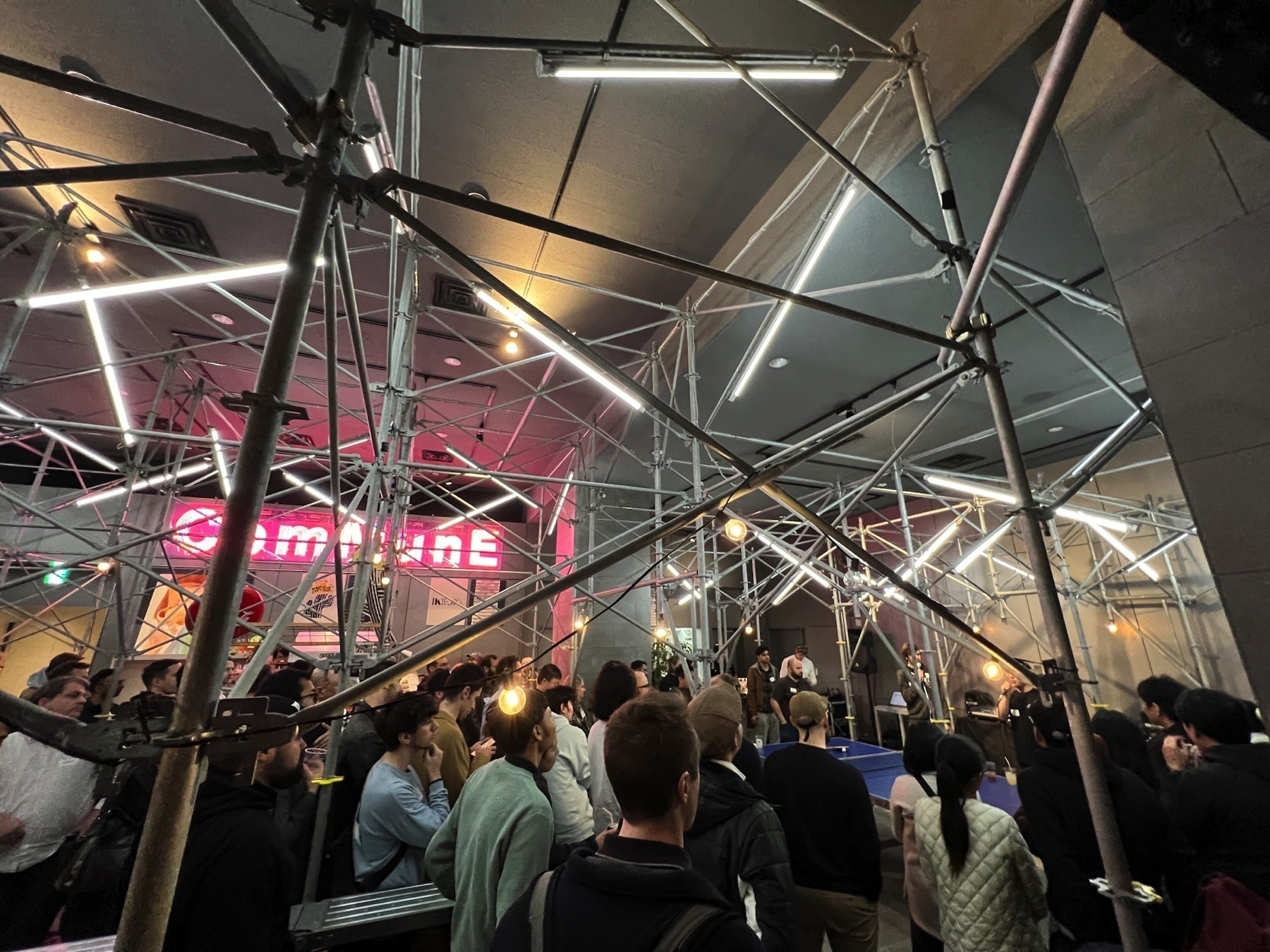
Community members gather to listen to announcements.
Engaging with a community of your peers is fun and rewarding. You never know who you will meet or what you will learn. And who knows what opportunities it might bring in the future?
I was a member of the HN Tokyo Slack community for 4 years before I even went to an event. In fact, I was introduced to it by a guy in the Fukuoka startup community. I am still in touch with those Fukuoka comrades… last year I was able to meet up with some at the Maker Faire in Kyoto. Nowadays I have been engaged with the the local Kansai HN and programmer community.
During the HN Tokyo event I introduced myself as a “diplomat from HN Kansai”. Many people came up to me afterwards, interested in hearing more about Kansai. I invited everyone to stop by our community meetups if they were ever in Osaka or Kyoto. I was even able to recommend places to visit in Fukuoka!
I enjoy going around to different communities and meeting people. As someone who has been between cultures (and locations!) for a long time, I suppose I also enjoy bridging different communities.
Back when I lived in the Okanagan every community had their “Geek Beers”-style of tech meetup. Working with friends in the neighbouring towns such as Vernon, Kelowna, Penticton, and Kamloops, we started an event where everyone in the region would congregate in one community. It was an annual summer event with a rotating host. We called it #megageekbeers. One year we even got corporate sponsorship to cover a bus to drive people to the next community over so they could arrive and get home safely!
I am still connected to the Kelowna and Vernon startup communities. We share job prospects, industry information, and memes 😜 through these networks across communities and now across borders.
Networking opportunities are super valuable at a personal level, whether for professional or fun reasons. We are all taught this early. But cross-community networking is how we can build movements. “Federation” has become a keyword in online social media the past couple of years. I think there is a huge opportunity to realize this concept IRL: let’s network our networks!
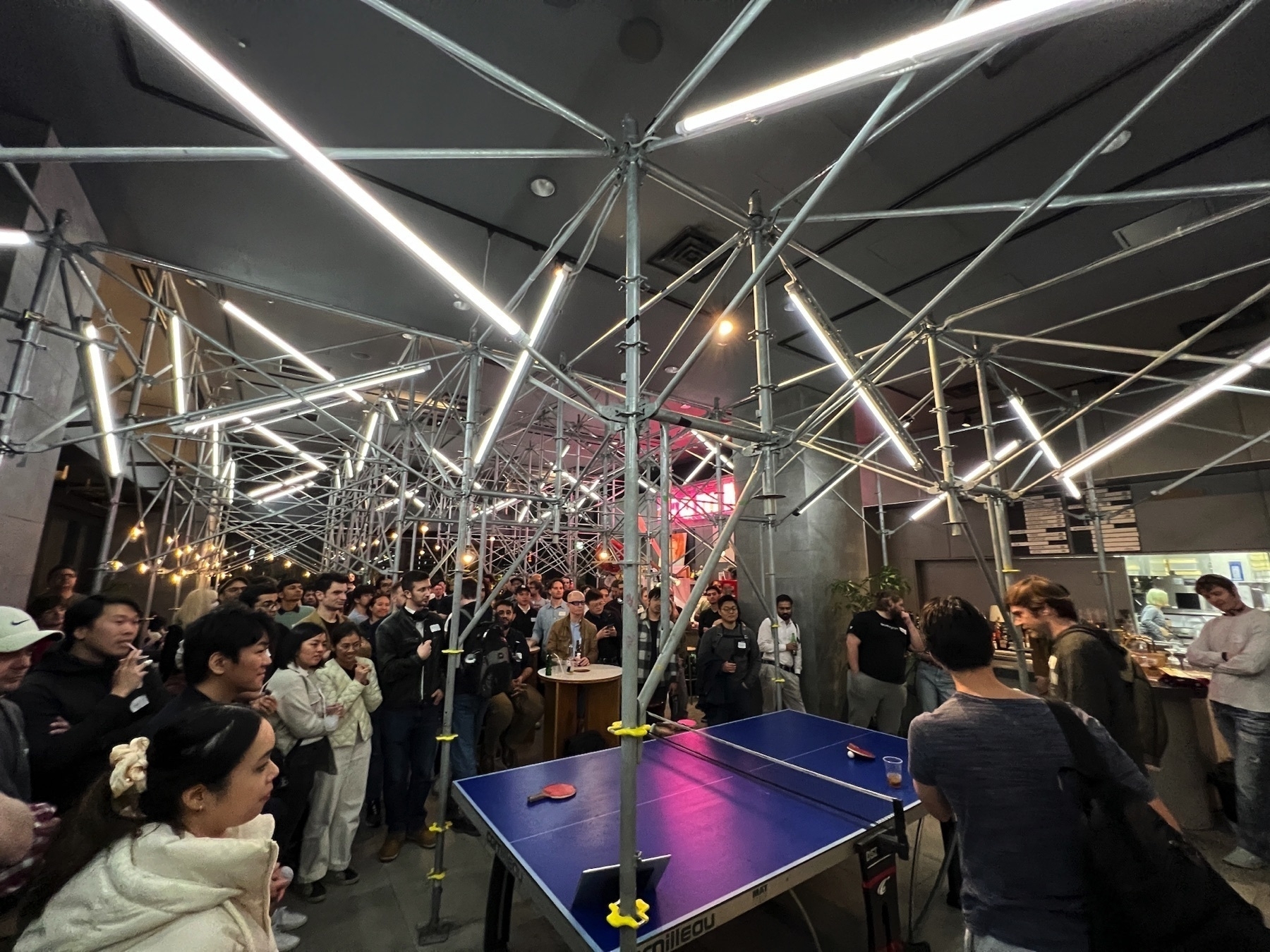
Community members step up to the mic to deliver announcements.
Hagia Sophia
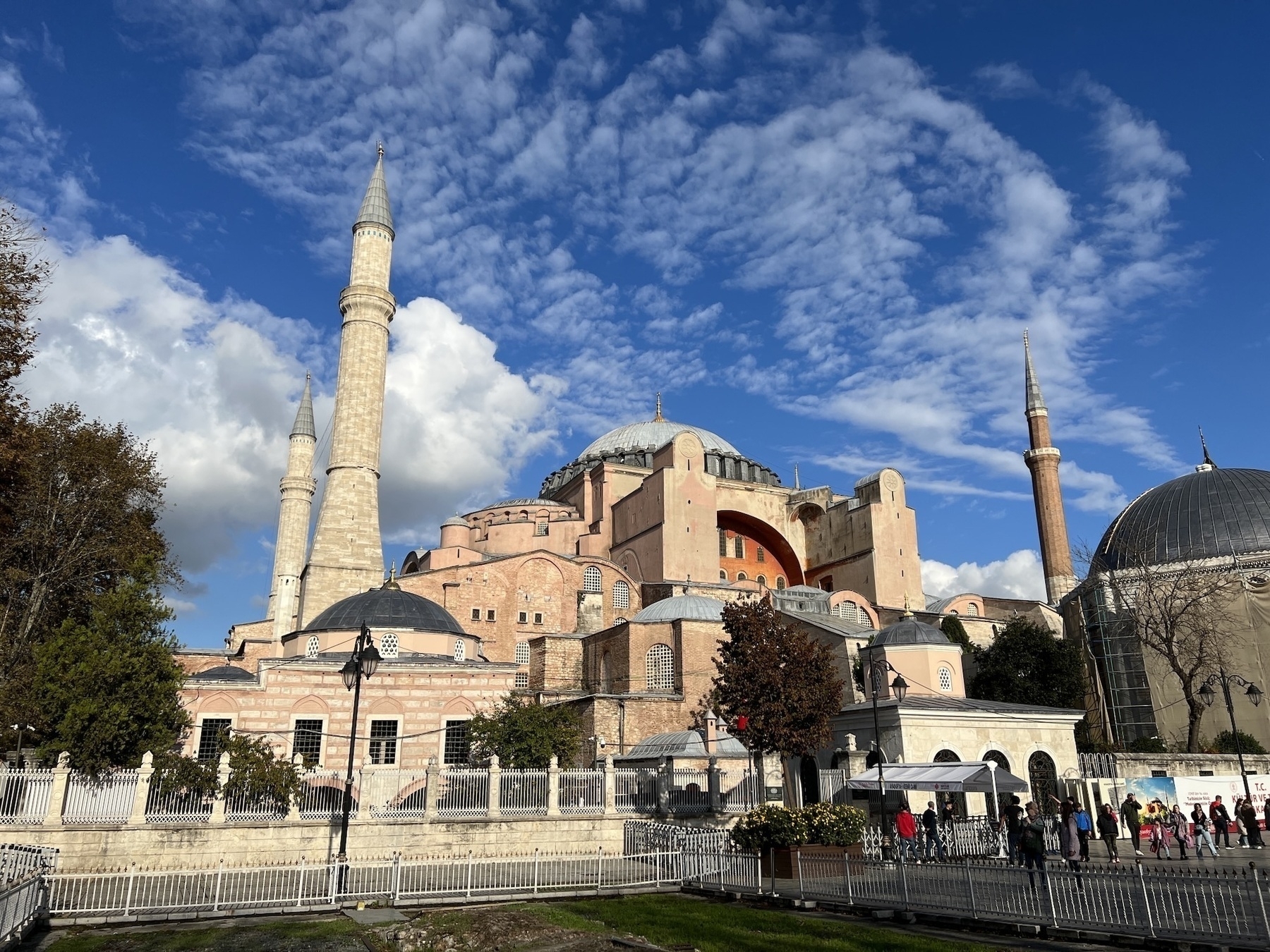
As described in my previous post, Istanbul is a city of layers. Nothing demonstrates this more than one of the gems of the city: the Hagia Sophia.
Built on the site of an earlier Christian church erected in 336 AD by Constantius II (son of the Emperor Constantine) the current building was made in the 532 AD by the Byzantine emperor Justinian I. For a thousand years it was the largest building in the world. Except for a short time as a Catholic church after the Fourth Crusade in the 13th century, the Hagia Sophia stood as a cathedral of the Eastern Orthodox tradition until the Ottomans conquered Constantinople in 1453. Since then the Ayasofya has been a grand mosque until 1935 when Atatürk, in his drive to secularize the newly founded Republic of Turkey, converted it to a museum. Most recently, in a controversial move in 2020, the long-serving conservative president Erdoğan converted it back into a working mosque.
This is the most barebones of history for structure that has been standing — and used — for more than fifteen centuries. The Ayasofya is an excellent symbol of the historical layers of the city of Istanbul, as throughout the centuries it has gained new additions, but with much of its original structure still shining through. I would like to give you just a few examples. Come with me on a short tour!
During my stay in Istanbul I went to the Ayasofya twice since it was so amazing. Both times I approached from the “back”… once coming down from the Topkapi Palace (photos) — which holds such treasures as the Topkapi dagger, the staff of Moses, and the arm of John the Baptist — the other time when a frustrated taxi driver angered by traffic dropped us off in a sidestreet saying merely “You walk from here”.
The Ayasofya stands across the plaza from the famous Blue Mosque, a beautiful built to purpose mosque made in the early 17th century. The Ayasofya in contrast has had so many additions as it changed civilizational hands that it looks more like something from the “lived in” universe of Star Wars.
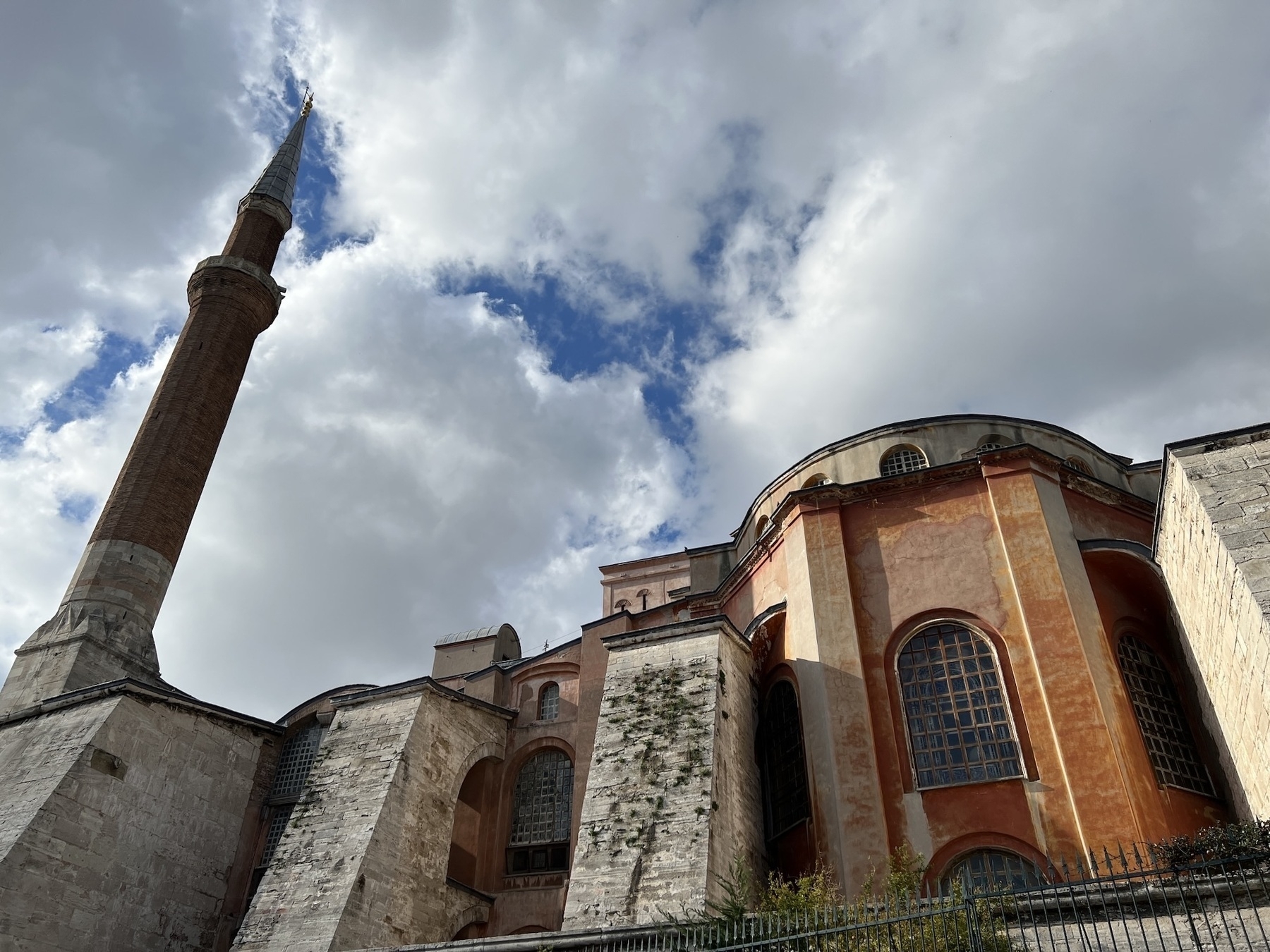
From the outside you can see the red walls of the original church. The massive dome (more on that later) is 32 meters across and so heavy that the church walls have been buckling so later architects installed buttressing to keep the walls standing straight. There are four minarets which were added at various times, one made of red brick, adding to the architectural pastiche.
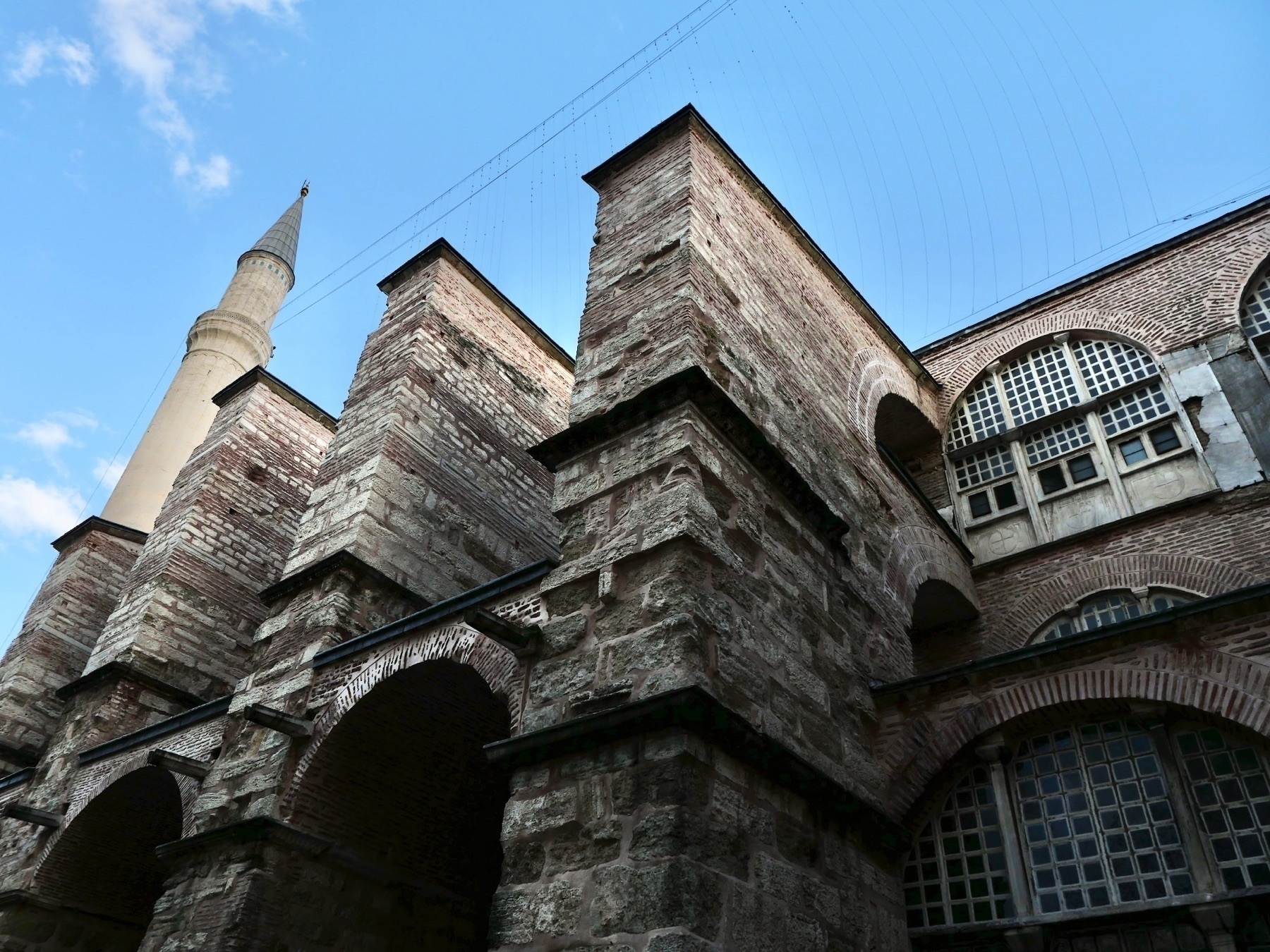
Circling around to the front you will see a line of people out into the plaza. Since the building is once again an operating mosque, five times a day tourists are shuffled out to make way for people doing their daily prayers. The line out front can get quite long as people wait during prayer times, but if you time it right you can basically walk right in. After passing some metal detectors you get a close view of the buttresses before entering the building from the side. In the outer hall you are treated to domed ceilings with golden tiled mosaics. It feels very Byzantine. Shoe lockers line the walls where you can store your footwear before entering the mosque. The marble thresholds have been worn down by the passing feet of millions of petitioners through the centuries, and look like melted butter.
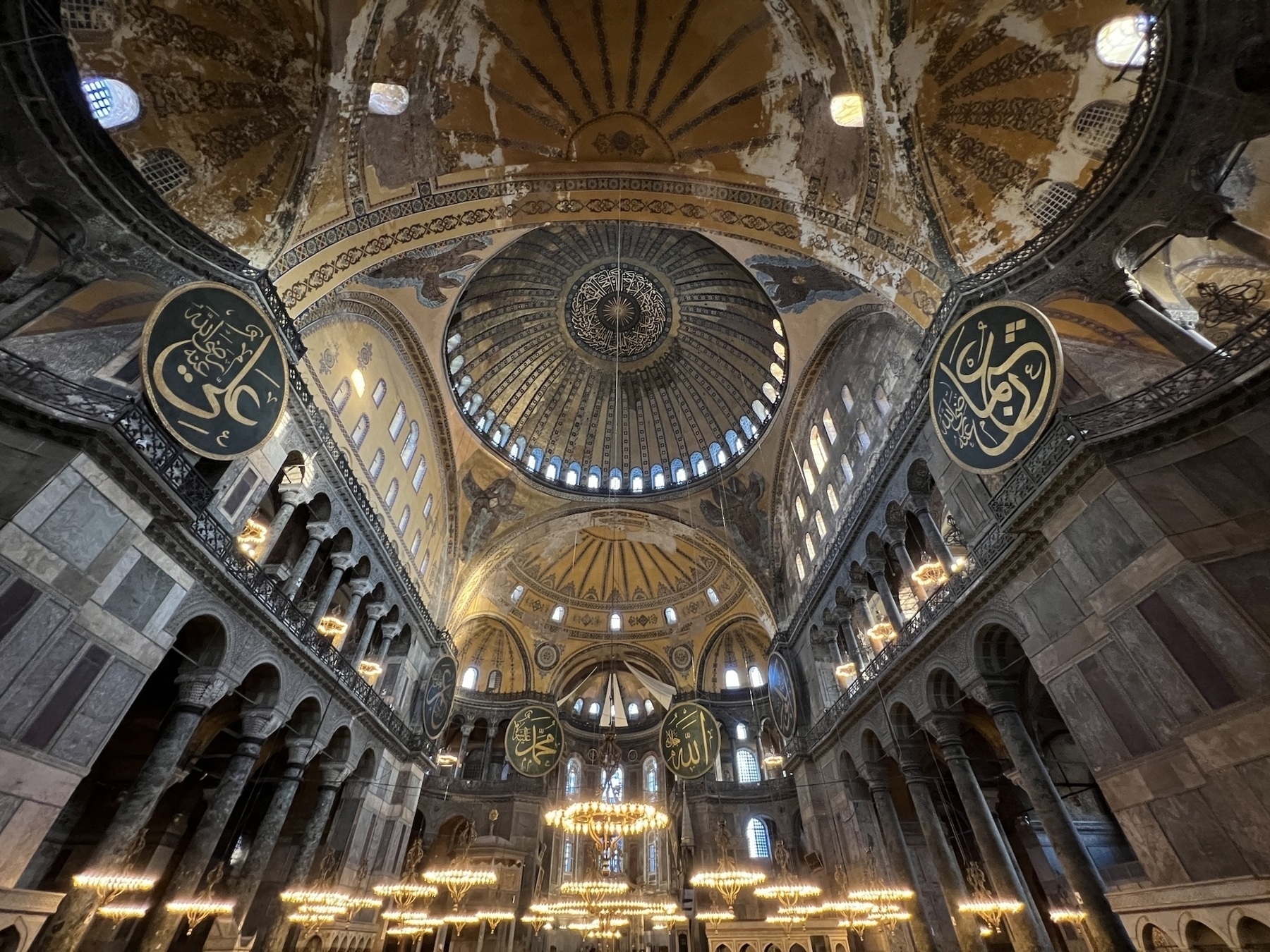
The crowd pushes you along to enter the cavernous building. Large circular chandeliers hang from the vaulting ceiling. Looking up — and everybody is looking up — two semi-domes help to prop up the 32 meter wide main dome which at its height it 55.6 meters above the floor. There are no supporting pillars in the middle of the building, so it feels absolutely huge inside.
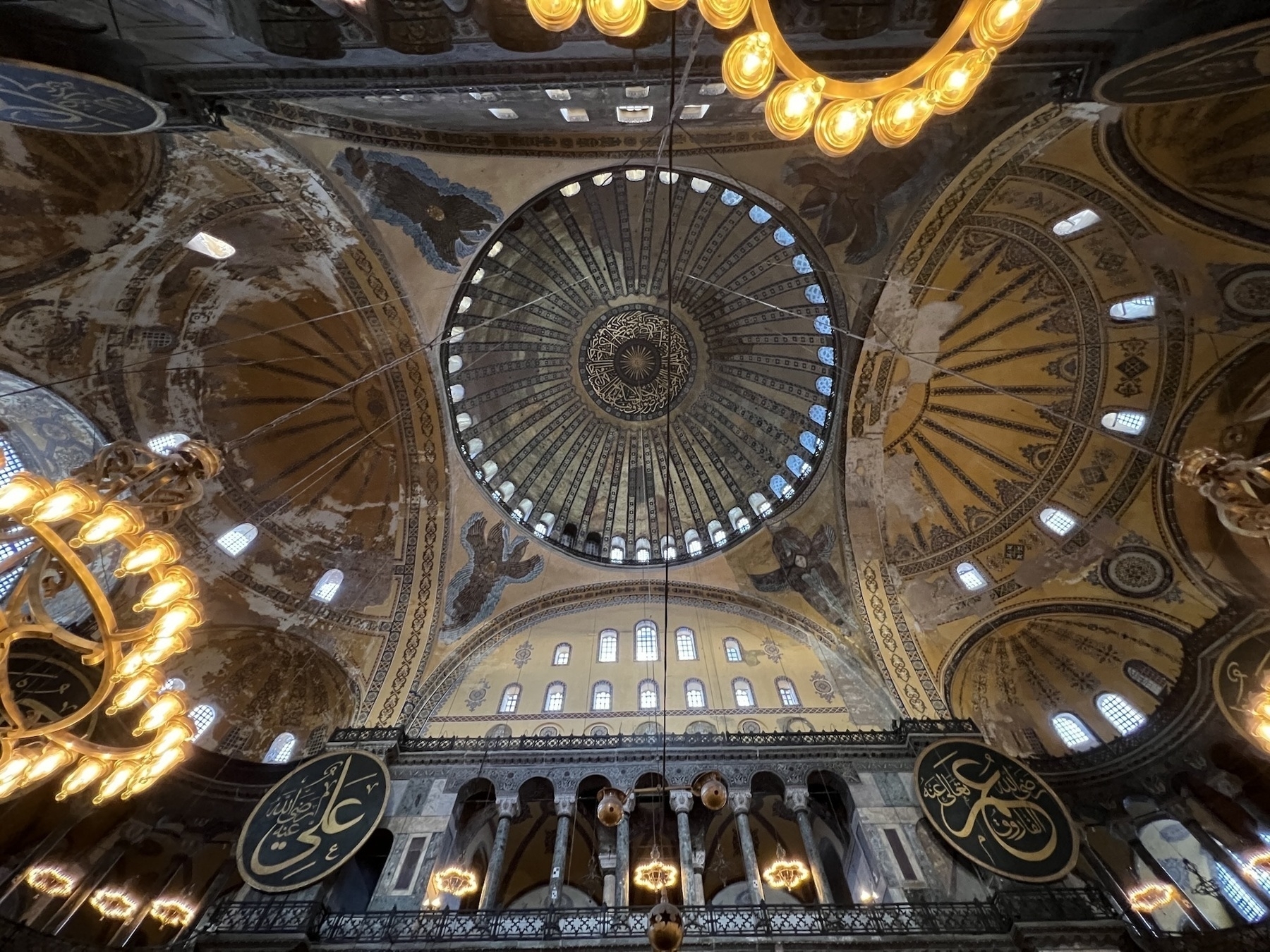
This wide angle shot from inside shows the two semi-domes on the left and right which support the main dome. Below are the pillars of the second floor, which you used to be able to go up into, but no longer. Around the center dome you can also spot the four “biblically accurate” angels who also support the dome. In the Ottoman era the faces of the seraphim were covered with stars, but one has been restored with its face.
Everywhere you go inside people are staring up in awe and taking photos. But there are many other details to look at other than the domed ceiling. The columns were imported from all over the Mediterranean and some have special stories. People sit on the floor and rest their backs against the columns as they gaze upward. But if you look downward, to the lush green carpet you find another asymmetry of time: the lines on the carpet are at an off-angle to the rest of the building. These are the lines that parishioners line up as they pray towards Mecca, which of course the building was not designed to line up with. I mean, it was constructed more than 60 years before the founding of Islam!
There are many, many more details but I hope this gives you a glimpse at not only of the historical significance of the Hagia Sofia, but also as a symbol of the history of Istanbul.
To see more photos and videos of the interior and surrounding area, including the call to prayer from the perfectly symmetrical Blue Mosque, see my album on Flickr.
Istanbul — Look around, feel history
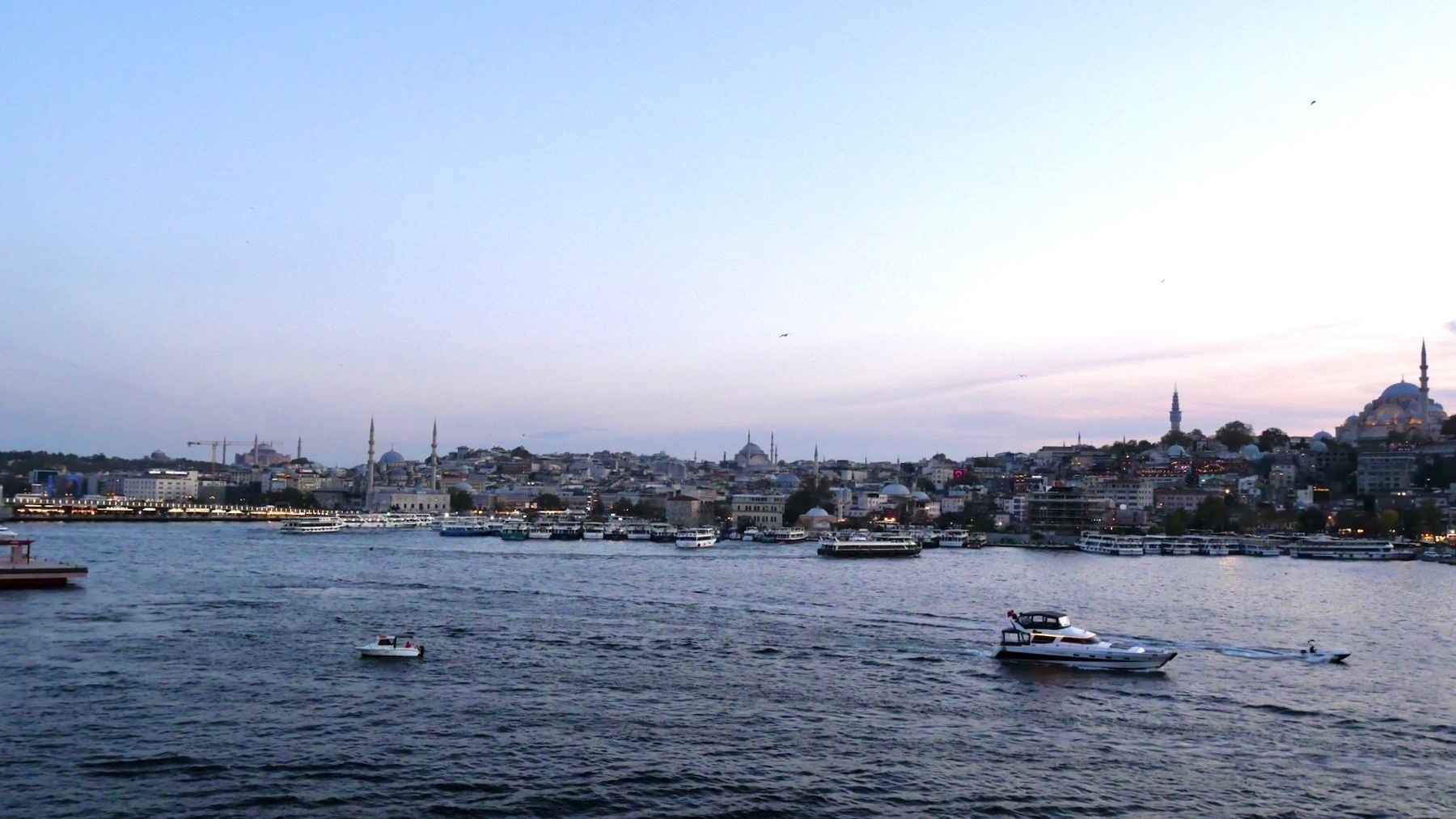
Istanbul, Constantinople, Nova Roma — the city at the crossroads of the world — is a city of layers. First settled 6000 years ago each new community was built on top of the previous. And being located at such a strategic point as the world’s only trans-continental city, there have been a lot of different people groups and empires with designs on the city.
I was in town for just over ten days, mostly for work, but my old pal Chris Gunson flew up from Dubai and we toured around together for a few days. Twenty years ago Chris and I used to talk and trade book recommendations about transcontinental history, but this was the first time we could walk old streets together (a meeting in Kazakhstan was aborted in 2004 for a bad visa, which redirected me southwards to Kashgar and the Pamir Plateau. A few pics from that trip long ago.)
This post serves as a bit of a trip report. You may want to read it while browsing the galleries of photos on Flickr, linked at the bottom of this post.

A sign through the window.
Istanbul has changed hands between the Greeks and Romans a number of times, before being conquered by the Ottomans in 1453. After so many years of Turkish rule, it is easy to forget that Istanbul was once part of “Magna Grecia”, Greater Greece, and even part of the Delian League. The old names of cities found in Thucydides and other classics are still there under Turkish localized names: Smyrna is now the seaside resort of İzmir; in 325 CE the First Council of Nicaea was held in the modern town of İznik; one afternoon we crossed the Bosporus in a small ferry to visit Kadıköy, an older area of the Asian side of Istanbul that used to be called Chalcedon, where the fourth ecumenical Christian council was held in 451 CE. This is in fact the area where archeological artifacts have been found dating back to 5500 BCE.
As Constantinople, the capital of eastern Christianity and inheritor of the Roman Empire after Rome fell and the West sunk into the Dark Ages, the city suffered many attempts at conquest by various people groups such as the Goths and Persians. It was impregnable, largely due to the massive triple city wall, first built by Constantine and then added to by King Theodoseus in the 5th Century. They held for a thousand years before finally being breached in 1453, when the Ottoman conquerers used massive cannons of Hungarian design to launch cannon balls weighing 500 kilograms into the walls. This created holes for the invaders to break through, but didn’t actually destroy the walls which still stand today. Just a short walk from the 1453 Museum, which describes the conquering of the city in very cinematic fashion, you can get right up to the walls. I saw tourists crawling up and inside. Today the wall runs alongside a freeway. From working class neighbourhoods inside the walls people drive their cars through old arched gates to access the freeway. Here and there in the green space between the walls and the freeway people have planted vegetable gardens!

5th century walls of Theodoseus.
The Ottoman period lasted until 1923 when the Republic of Turkey was founded by Mustafa Kemal Atatürk who transformed Turkish society. Driving into the city from Istanbul Airport, the busiest airport in Europe, I immediately noticed all the Turkish flags hanging from apartment windows and strung along and across the streets. This year is the 100th anniversary of the founding. Not only that, but the day after I landed was the anniversary of Atatürk’s death, on November 10th 1938 at 9:04am. Why do I know the time? Well, while we were having breakfast at the rooftop restaurant of my hotel, with an epic view of the sunrise over the Asian side of the city, all of a sudden I could hear the horns of the ships in the harbour blasting simultaneously. I thought it was some sort of earthquake warning or air-raid siren. Looking around I noticed all the hotel restaurant staff line up and stand at attention. Not knowing what was happening I stopped eating and just waited for something to indicate what was going on. After a minute of very loud silence, the staff went back to work and the harbour continued to buzz with activity. This happens every year, and I heard from one Turkish man that back in the day drivers would stop and get out of their cars to stand by open driver doors out of respect.
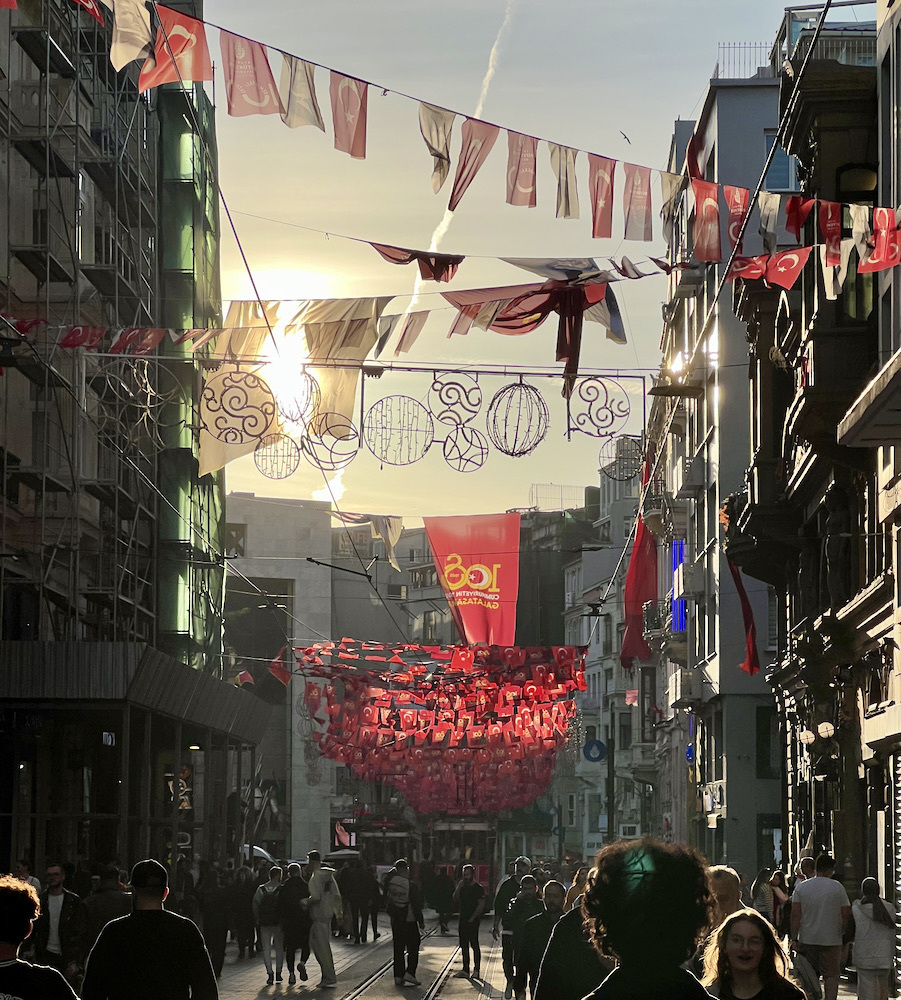
Turkish patriotism hangs above everyone’s heads.
Evidence of the 100 year anniversary are all over. Many shops have 100th Anniversary marketing displays in their windows. At Taksim Square, a large plaza in the heart of the tourist district, is a massive circular display blaring out patriotic messages featuring smiling families, guns, and fighter planes. There is a huge light show at the gigantic new mosque on the square, an initiative by the long-time President Recep Tayyip Erdoğan. Taksim Square is normally thought of as a symbol of the country’s republicanism and secularism. The new mosque, completed in 2021, is a conspicuous symbol of conservatism on Turkey’s contemporary politics.
Erdogan’s presence is easily spotted across the city. He used to be mayor of the city, but ever since the AKP got into national power and he became president, the politics of the country have slanted more conservative. Some of Erdogan’s initiatives, what he himself has called his “crazy ideas”, are large scale construction projects such as the controversial Istanbul Airport (for whom allegedly all the building and maintenance contracts went to his relations) and his giant canal proposal. Other initiatives are more on the side of promotion of Islamic culture, like the controversial Taksim Mosque. When looking across the Bosphorus Strait from my hotel, the horizon of the Asian side of Istanbul is dominated by two structures. First is the giant Çamlıca Tower, the tallest structure in Istanbul, a telecom tower with observation deck and restaurants. To the left is the Grand Çamlıca Mosque, the largest mosque in Turkey able to hold 63,000 worshippers for prayer times. This mosque was opened in 2019 and sometimes referred to in the streets as “His Mosque”. You will note that it has 6 minarets.
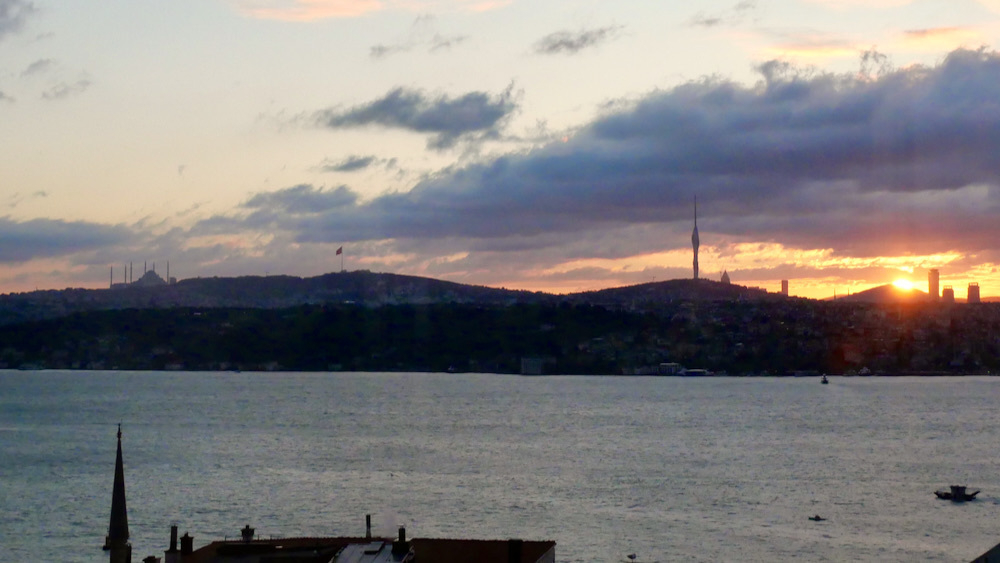
Tower to the right, mosque to left.
The only other mosque in Istanbul to have such a thing is the beautiful Blue Mosque, across the river to the south on the Golden Horn in the old city. This mosque was built in the early 17th Century by the master architect Sinan (who was obsessed with the Hagia Sophia, topic of a future post) at the direction of Sultan Ahmed I. At the time, the only other mosque with six minarets was the mosque of the Ka’aba in Mecca. When the Blue Mosque was completed people were shocked at the audacity, thinking the Sultan too proud. To resolve the situation he sponsored a seventh minaret at Mecca.
The area around the Blue Mosque is spectacular to walk around. But beware of the terrible Istanbul traffic in getting there! One time we had a taxi driver frustrated and yelling at everyone around us stop the car and get out, go five cars up to yell and someone, then came back to tell us “You walk from here.” In front of the Blue Mosque is a plaza that is built upon the old Hippodrome which is a few layers down. As the capital of Eastern Rome they people needed their bread and circuses! In ancient times the spina of the hippodrome, the long section down the middle which charioteers would race around, used to have many treasures brought from across the empire. Now only three remain: an obelisk brought from Egypt In 390 CE which dates to 1490 BCE; another obelisk of more murky past; and the remains of the Serpent Column which Constantine brought from Delphi in 324. I was very excited to see the Serpent Column, a bronze pillar cast by the Greeks in celebration of their victory against the invading Persians in the 5th century BCE. This thing is 2500 years old and just sitting outside! You can go and see it any time. Amazing!
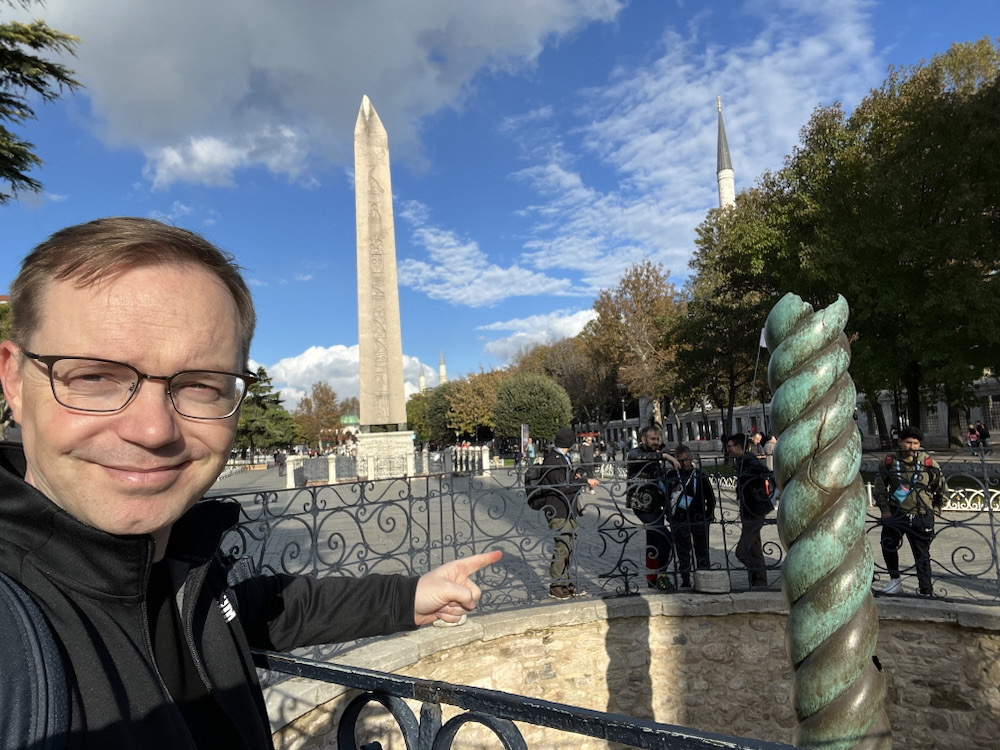
Very excited to be so close to a 2500 year old artifact!
My most favourite thing of this area is the Hagia Sophia, the cathedral originally built in the 4th C and converted to a mosque in 1453. That deserves its own post.
In cold winds and rain I wandered from the Blue Mosque and the Ayyasofia up to the Grand Bazaar, a mostly covered shopping area with over 4000 stores. Here I badly negotiated for a box of delicious Turkish Delight and a nazar pendant. I am terrible at negotiating in these situations. Though all in all I think I did pretty well and was never taken for a real ride. Once we fell for the old shoeshiner- dropped-brush-scam, but other than that, our wallets were safe.
The weather was bad for some of the days. The wind rocked our ferry crossing back from the Asian side, and one freezing morning when I went to the local Kathie Dunyasi (a kind of Turkish Starbucks) all the seats were taken by cats who came in from the cold!
Other days the sky was a gorgeous blue and we could walk the steep, narrow streets around the Galata Tower, the historic district of Genoese traders. The cobblestones and European buildings reminded me of Lisbon. I have now been to the Westernmost and Easternmost edges of Europe, but never in between. Also, both Lisbon and Istanbul are Cities with Seven Hills! I am cursed! (However, I found out later that many more cities claim this honour).
On another sunny day I was able to walk up to the Topkapi Palace, built by the Sultan and home to many treasures. The Palace is located at the tiP of the Golden Horn and affords clear views of the north part of Istanbul and the main bridge that crosses the Bosphorus to the Asian side of the city. Inside the complex we wended our way through the harem, visited the sultan’s chamber room and bath, and took in all sorts of treasures like the Topkapi Dagger, which features massive emeralds on its hilt. I first saw the Topkapi dagger in Osaka many years ago when it was on tour around the world. I was very glad to see it in its home.
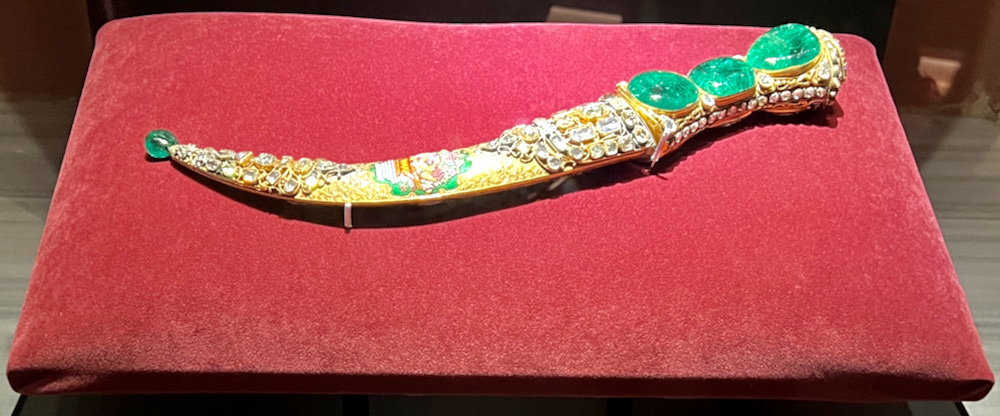
The Topkapi Dagger, in all its shiny glory.
In 1204, during the Fourth Crusade, the city was ransacked by Europeans at the behest of Rome. They destroyed much, but also stole important Christian relics like the robe of Mary and probably the Shroud of Turin. There still remain some artifacts, held in Topkapi Palace. There you can see the relics like the arm of John the Baptist, the staff of Moses, David’s sword, and a whole bunch of personal belongings of the Prophet Muhammad.
It was short, but I enjoyed walking the hills of this old city, visiting just a couple of its 3500 mosques and two of its many football stadiums. I ate well, but did not get the opportunity to enjoy a Turkish bath. Also, there are a lot of smokers, both inside and outside of restaurants, so beware! (In fact even the taxi drivers smoked like chimneys while they raced through the streets, or sat perfectly still in traffic banging on their car horns.)
In preparation for the trip I read Thomas F. Madden‘s Istanbul: City of Majesty at the Crossroads of the World which gave me just enough detail to appreciate the layers of history of the city. Also, check out the episode of Geography Now on Turkey which is lots of fun.





